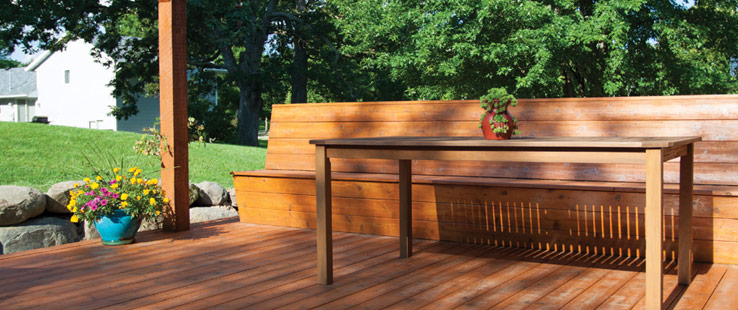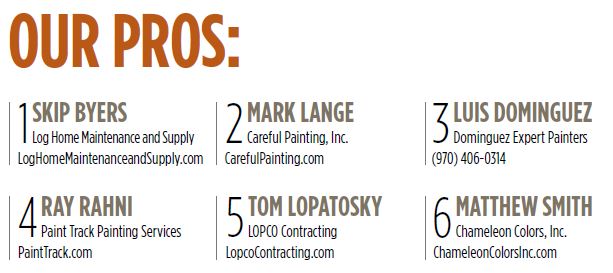PRO PICKS: Six pros on their go-to exterior stains
 Depending upon your location, wood exteriors can take a beating: snow, wind, strong sun, heavy rains. And every project is different. Siding, decks and railings—never mind different types of wood—may call for different stains, so it’s wise to study up on the stain characteristics that will work best for your project.
Depending upon your location, wood exteriors can take a beating: snow, wind, strong sun, heavy rains. And every project is different. Siding, decks and railings—never mind different types of wood—may call for different stains, so it’s wise to study up on the stain characteristics that will work best for your project.
1. FROM OUR PRO:
Skip Byers, owner of Log Home Maintenance and Supply in Denver, CO, has worked with wood for more than 25 years—including staining and restoring log homes. Since 2008, he’s been in the business of selling products to contractors and homeowners to care for their log homes.
His top stain pick? Sashco’s Transformation Stain, Log and Timber. “I have it on the exterior of my own log home,” he says.
Byers likes the stain’s look and the wide array of color options available.
“It shows the grain nicely,” he says. “It has a glossy sheen, but it’s not too shiny or fake-looking.”
The durability is a factor as well. “Most of our customers are high in the Colorado mountains, and there’s intense sun at those high elevations,” he says. “Nothing lasts longer than this.”
2. FROM OUR PRO:
Mark Lange pulls no punches about his favorite stain. “I’m a Benjamin Moore guy,” says the owner of Minnesota-based Careful Painting, Inc. With 37 years in the industry, Lange focuses on high-end residential work.
For most exterior projects, Benjamin Moore’s ARBORCOAT Waterborne Exterior Stain (solid) is Lange’s go-to.
He appreciates that it doesn’t leave lap marks.
“With a lot of stains, you’ll see overlap—a double-coated area—when you start and stop,” he explains. “Arborcoat doesn’t do that. That’s extremely important, especially with dark colors.”
Plus, it sprays well … and he likes Benjamin Moore’s range of colors, he says.
“And three to four years later, it touches up well,” Lange adds. “That’s rare for a stain.” Moreover, it’s a good value for the money, he says.
For deck work, Lange typically turns to Benjamin Moore’s ARBORCOAT Classic Oil Finishes (semi-solid).
The Arborcoat, Lange says, doesn’t peel the way some stains do. “I also like that I can usually do one coat,” he notes. “And it lasts longer than the semi-transparent.”
3. FROM OUR PRO:
Luis Dominguez of Dominguez Expert Painters in Colorado has been painting for more than 15 years and handles a lot of log-home projects. For those projects, he has a few go-to stains: Sikkens’ ProLuxe Cetol Log & Siding, Sikkens’ ProLuxe Cetol SRD, and Sascho’s Capture Log Stain (used with the Cascade Clear Coat).
Their easy application and durability help these products rise to the top of his list. Dominguez handles exterior and interior residential and commercial projects and relies on referrals for business, so choosing the right stain is key.
4. FROM OUR PRO:
Understanding your material and substrate is key to picking the right stain, says Ray Rahni, owner of Paint Track Painting Services, based in the greater New York area. In business since 2004, tackling an array of residential and commercial projects, Rahni typically gravitates toward Benjamin Moore’s ARBORCOAT Premium Exterior Stain.
“I prefer the semi-solid, because it’s lower maintenance and there’s less chance of peeling,” he says. “If you have new, untreated wood, I always recommend a thorough sanding followed by a coat of the semi-solid. You can apply a coat every three to four years to horizontal surfaces such as a deck, and seven years on vertical surface such as siding. The stain holds up really well.”
However, if the surface is very old or has been previously painted, Rahni often chooses the solid finish.
For hard or exotic woods (mahogany, cedar or redwood, for example), Rahni prefers DEFY’s Deck Stain for Hardwoods, a synthetic, semitransparent deck stain specifically formulated to penetrate these dense woods.
It’s hard to find stains that last more than a year on these hardwoods, Rahni says. “But Defy holds up better than the rest,” he says. “Just make sure you do a maintenance coat every year.”
5. FROM OUR PRO:
In Tom Lopatosky’s experience, home exteriors and decks have different needs. Lopatosky’s company, LOPCO Contracting, focuses mainly on residential jobs in Rhode Island and southern New England.
For a solid stain on a home’s exterior, he likes Benjamin Moore’s ARBORCOAT Waterborne Exterior Stain (solid or semi-solid).
“Arborcoat,” he says, “is a solid system. We find it to be more fade resistant than many other stains on the market.”
Plus, Lopatosky is a huge fan of Benjamin Moore’s Gennex colorant system, which boasts durability, excellent fade resistance, and zero VOCs.
While he sometimes uses Arborcoat for decks as well, he has found that C2 Paint has a stellar option as well.
“C2 Guard, C2 Paint’s clear water protectant, is the best clear protectant out there if your sole purpose is guarding a bare-wood deck against moisture,” says Lopatosky, who started his business more than 20 years ago. This deep-penetrating product is available for both wood and masonry.
It’s designed to go on a bare surface, he explains, noting that in addition to the clear option, the semi-transparent line offers 15 stain colors.
“Be sure not to use it over a previously coated surface,” he says. “It’s best used with natural, bare wood.”
6. FROM OUR PRO:
Matthew Smith, owner of Chameleon Colors, Inc. primarily works on waterfront homes on Bainbridge Island, near Seattle.
“They’re prone to extreme conditions and exposure from all sides,” he explains. And there’s a lot of cedar wood.
For exterior vertical wood surfaces, Smith turns to Sikkens’ ProLuxe Cetol Log & Siding, which has a high-performance, translucent, satin finish. He also likes Sikkens ProLuxe Cetol Door & Window, which is designed to prevent weathering.
“To me, it’s a proven product line,” Smith says. “I’ve used it for almost 20 years now; I know it’s durable, and I know what it’s going to need five, 10 and 15 years down the line.”
For a painter with a lot of repeat business, understanding of—and confidence in—his product is key.
“Some of the first houses I painted on the island I still maintain,” he says. Painting, he advises customers, is labor-intensive. “About 85% of the cost of a good paint job is labor,” he says. “So, for that remaining 15%, I want to use the best material I can. Although Sikkens stains are almost twice the cost of other stains, they last longer. They’re the most durable product.”





